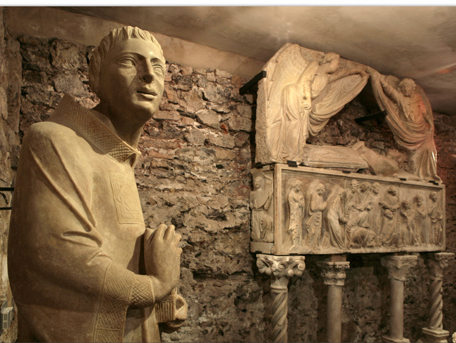The third tomb that enters the story is that of Cardinal Luca Fieschi.
He was an immensely powerful and wealthy man of the church in the early 1300s, and was ‘head’ of the Fieschi family until his death in January 1336. If there is any truth in the Fieschi Letter, and if Ian Mortimer is right that we should interpret it as meaning that the Fieschis were Edward II’s ‘keepers’ after his apparent death in Berkeley Castle, it was almost certainly at the instigation of Luca Fieschi.
He was a kinsman of both Edward II and of the Marquess of Oramala of the Malaspina family, who was the overlord of the Staffora Valley and descendant of the founders of the Abbey of Sant’Alberto itself. Ian Mortimer’s interpretation of the Fieschi Letter makes sense, in so far as Edward II is supposed to have been assisted in his ‘afterlife’ by his kinsman, Luca Fieschi, and by Luca Fieschi’s own kin, the Malaspina family, in their territory in the Staffora Valley. There is more on the Malaspina family in the interview with historian Luciano Maffi on our blog.
This also explains why the Malaspina archive of Godiasco is highly likely to prove the key to the whole affair, as soon as it is opened.

La terza tomba che partecipa alla nostra storia è quella del Cardinale Luca Fieschi. Era un uomo di chiesa ricco e con un immenso potere agli inizi del 1300, e fu il “capo” della famiglia Fieschi fino alla sua morte, avvenuta nel gennaio del 1336. Se esiste un briciolo di verità nella lettera Fieschi, e se Ian Mortimer avesse ragione e dovessimo pensare che i Fieschi fossero i “custodi” di Edoardo II dopo la sua apparente morte al Castello Berkeley, è quasi sicuro che tutto ciò derivi da Luca Fieschi. Era un consanguineo sia di Edoardo II che del Marchese di Oramala della famiglia Malaspina, che era il signore della Valle Staffora e discendente dei fondatori dell’Abbazia di Sant’Alberto. L’interpretazione della lettera Fieschi di Ian Mortimer ha senso, finché si suppone che Edoardo II sia stato assistito nella sua “vita nell’aldilà” dal suo consanguineo, Luca Fieschi, e dai parenti di Luca Fieschi, la famiglia Malaspina, nel loro territorio nella Valle Staffora. C’è altro materiale sulla famiglia Malaspina nell’intervista con lo storico Luciano Maffi sul nostro blog.
Questo spiega anche perché sia molto probabile che gli archivi Malaspina di Godiasco possano dimostrare la chiave dell’intera faccenda una volta aperti.